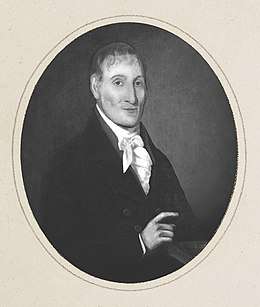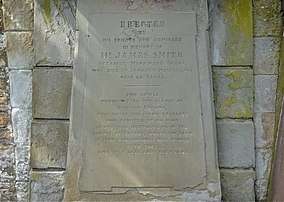James Smith (Scottish botanist)
James Smith (c. 1763 – 1 January 1848) of Monkwood Grove was a Scottish botanist and nurseryman. He founded the Monkwood Botanic Garden in Maybole Parish which included several thousand species of exotic and native British plants. A regular consultant of his more eminent contemporaries, he is credited with the discovery of Primula scotica and Salix caprea pendula.

Biography
Smith was born in Ayrshire, Scotland around 1763. Sometime in the eighteenth century, he established a nursery at his home on the Monkwood estate near Minishant along the River Doon, which eventually became the Monkwood Botanic Garden. At Monkwood he amassed a large collection of rare and valuable plants which, according to Loudon’s Encyclopaedia of Gardening, comprised thirty-five hundred different species of both exotic and indigenous varieties.[1] At his nursery, he employed and mentored his future son-in-law, the botanist John Goldie for whom Dyopteris goldieana is named.[2] Passing through Monkwood on one occasion, the poet Hew Ainslie wrote in his A Pilgrimage in the Land of Burns (1820) that Smith's garden was "paradisiacal", where plants "of all nations were seated most brotherly together, drinking of the same dews, and dancing to the piping of the same breeze".[3]

Owing to his vast botanical knowledge and equally formidable collection of plants, Smith was regularly consulted by such contemporary botanists as Sir William Jackson Hooker and Sir James Edward Smith who included his information on botanical subjects in their works.[4] As mentioned in Hooker's Flora Scotica (1821), Smith is credited with the discovery of Primula scotica,[5] Veronica hirsuta[6] and the Kilmarnock Weeping Willow (Salix caprea pendula).[7]
Smith died on 1 January 1848, aged 84. His gravestone in the Ayr Auld Kirkyard erected by his admirers describes him as the "father of Scottish botany".[8] By the end of the nineteenth century, both the house and garden at Monkwood had gone, however many of Smith's rare plants remain on the grounds.[9]
References
- Notes
- Loudon, J. C. (John Claudius) (1825). An encyclopaedia of gardening; comprising the theory and practice of horticulture, floriculture, arboriculture, and landscape-gardening, including all the latest improvements; a general history of gardening in all countries; and a statistical view of its present state, with suggestions for its future progress in the British Isles. University of California Libraries. London : Longman, Hurst, Rees, Orme, Brown, and Green. pp. 1206.
- "John Goldie, Gardener and Botanist". Botanical Gazette. 11 (10): 272–274. 1886. doi:10.1086/326018. ISSN 0006-8071. JSTOR 2994671.
- Ainslie, Hew; Burns, Robert (1822). A Pilgrimage to the Land of Burns: Containing Anecdotes of the Bard, and of the Characters He Immortalized, with Numerous Pieces of Poetry, Original and Collected. author. pp. 140–144.
- Gray, James T. (1972). Maybole: Carrick's Capital. Ayr: Alloway Publishing. ISBN 9780907526094.
- Journal of Botany, British and Foreign. Robert Hardwicke. 1899. p. 136.
- Hooker, William Jackson (1821). Flora Scotica; Or a Description of Scottish Plants, Arranged Both According to the Artificial and Natural Methods. In Two Parts. By William Jackson Hooker ..: Containing generic and specific characters, with descriptions and remarks of the 23 first classes of the Linnæan system. Richard and Arthur Taylor, Shoe-Lane. p. 6.
- "John Goldie, Gardener and Botanist". Botanical Gazette. 11 (10): 272–274. 1886. doi:10.1086/326018. ISSN 0006-8071. JSTOR 2994671.
- Find A Grave, database and images (https://www.findagrave.com : accessed 13 March 2020), memorial page for James Smith (1763–1 Jan 1848), Find A Grave Memorial no. 188100030, citing Auld Kirk Burying Ground, Ayr, South Ayrshire, Scotland ; Maintained by William Weston (contributor 49153494) .
- Douglas, Henrietta and Hugh (1983). MINISHANT IS A BONNIE WEE PLACE: PORTRAIT OF A VILLAGE. Glasgow: Strathprint. ISBN 9780904096897.
- Bibliography
- "The Ayrshire Directory for 1830". The Landscape Changes. http://www.maybole.org/community/minishant/book/landscapechanges.htm
- "The Weeping Willow. Salix Baby-Lonica" Chest of Books http://chestofbooks.com/gardening-horticulture/Journal-3/The-Weeping-Willow-Salix-Baby-Lonica.html